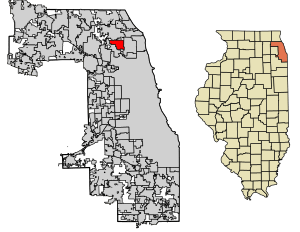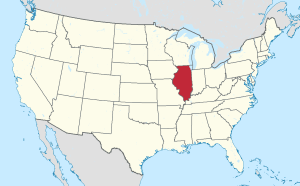Morton Grove, Illinois facts for kids
Quick facts for kids
Morton Grove, Illinois
|
|
|---|---|
| Village of Morton Grove | |

Morton Grove station
|
|
| Nickname(s):
The Grove
|
|
| Motto(s):
"First in service.."
|
|

Location of Morton Grove in Cook County, Illinois.
|
|

Location of Illinois in the United States
|
|
| Country | United States |
| State | Illinois |
| County | Cook |
| Township | Maine, Niles |
| Founded | 1895 |
| Area | |
| • Total | 5.09 sq mi (13.18 km2) |
| • Land | 5.09 sq mi (13.18 km2) |
| • Water | 0.00 sq mi (0.00 km2) |
| Elevation | 623 ft (190 m) |
| Population
(2020)
|
|
| • Total | 25,297 |
| • Density | 4,971.89/sq mi (1,919.60/km2) |
| Time zone | UTC-6 (CST) |
| • Summer (DST) | UTC-5 (CDT) |
| ZIP Code(s) |
60053, 60054, 60055
|
| Area code(s) | 847 |
| FIPS code | 17-50647 |
| GNIS feature ID | 413865 |
Morton Grove is a village in Cook County, Illinois, United States. As of the 2010 census, the population was 23,270, for a growth rate of 3.6% since 2000.
The village is named after former United States Vice President Levi Parsons Morton, who helped finance the Chicago, Milwaukee and St. Paul Railroad (later the Milwaukee Road), which roughly tracked the North Branch of the Chicago River in the area and established a stop at the old Miller's Mill. Miller's Mill Road, now Lincoln Avenue, connected the former riverside sawmill to the township's central settlement (Niles Center, now Skokie). The railroad stop facilitated trade and development; the upstart neighborhood grew enough to incorporate in December 1895.
Contents
Geography
Morton Grove is located at 42°2′28″N 87°47′11″W / 42.04111°N 87.78639°W (42.041146, -87.786456). According to the 2010 census, Morton Grove has a total area of 5.09 square miles (13.18 km2), all land. The North Branch of the Chicago River runs through the middle of the suburb within Cook County Forest Preserve area.
History
Potawatomi Native Americans, followed by French traders, first inhabited the area around present day Morton Grove. Farmers from England, Germany and Luxembourg started arriving in the 1830s. The community was named after banker Levi Parsons Morton. Morton was a vice president of the United States and an ambassador to France, who also served in the U.S. House of Representatives. He became the Governor of New York just eight days after the village was incorporated, December 24, 1895, as the Village of Morton Grove. The first mayor, George Harrer, was of German descent and the largest park in the village is named after him (and his brother was the Mayor of Skokie).
The earliest inhabitants witnessed open prairies resembling vast seas of tall grasses and wildflowers on the flat land left by retreating glaciers. Most of these original prairies were later utilized for agriculture, and the rich soil attracted farmers. The Chicago River provided water and power to operate that area’s first sawmill in the 1830s, giving the area the name Miller’s Mill, after the owner of the saw mill located on the river just south of Dempster Street. Local farmers traveled along Miller's Mill Road (later Lincoln Ave.) to sell their produce in Chicago. They later traveled along the railroad, when it came through in the 1870s.
Greenhouses arrived in the 1890s and quickly grew into the world’s largest floral business. The floral business received worldwide recognition for taking first place for roses at the 1904 St. Louis World’s Fair. With the end of the 19th into the 20th century, the village continued to grow and prosper as it welcomed home those who fought in World War I. As the Jazz Age roared on, one of the changes that illustrated the new era was the transformation of farmland into a small airfield that existed north of Dempster St. from 1919 to 1932.
During the late 1920s and 1930s, Morton Grove had a reputation as gambling destination and was the location of many roadhouses. Originally the home of the Huscher family before it was converted into a “swanky roadhouse" the Dells roadhouse eclipsed its competition. Located at the northwest corner of Austin and Dempster, it became the best known and most patronized of the roadhouses in Morton Grove, Illinois. The Dells offered live music and entertainment, dancing, fine food, comfort and ambiance. The Dells was an incredibly popular and successful commercial enterprise. It boasted a spacious dance floor, broadcast its music performances over the radio airwaves, and, because it was not subjected to the musician union local controls within the city, freely imported nationally renowned musicians and entertainers. The Dells had tasty cuisine in a well appointed setting on a tranquil wooded lot. Many businesses began to flourish during the "Jazz Age" in the village when the Morton Grove Chamber of Commerce & Industry was founded in 1926.
The Great Depression caused the village to meet the challenges of an uncertain economy as another world conflict loomed. After World War II, a new era of growth and prosperity began as Morton Grove entered the “Baby Boom” era. People seeking a better life ventured into the suburbs from Chicago and found Morton Grove, especially after the Edens Expressway opened. The population of Morton Grove grew from 2,010 in 1940 to 3,926 by 1950. The population soared to 20,533 in 1960, reaching a population of 23,270 by the 2010 Census.
Demographics
| Historical population | |||
|---|---|---|---|
| Census | Pop. | %± | |
| 1900 | 564 | — | |
| 1910 | 836 | 48.2% | |
| 1920 | 1,079 | 29.1% | |
| 1930 | 1,974 | 82.9% | |
| 1940 | 2,010 | 1.8% | |
| 1950 | 3,926 | 95.3% | |
| 1960 | 20,533 | 423.0% | |
| 1970 | 26,369 | 28.4% | |
| 1980 | 23,747 | −9.9% | |
| 1990 | 22,408 | −5.6% | |
| 2000 | 22,451 | 0.2% | |
| 2010 | 23,270 | 3.6% | |
| 2020 | 25,297 | 8.7% | |
| U.S. Decennial Census | |||
As of the census of 2010, there were 23,270 people, 8,199 households, and 6,288 families residing in the village. The population density was 4,406.4 people per square mile (1,699.7/km2). There were 8,305 housing units at an average density of 1,630.0 per square mile (628.7/km2). The racial makeup of the village was 66.2% White, 1.2% African American, 28% Asian, and 2.7% from two or more races. Hispanic or Latino of any race were 4.40% of the population.
There were 8,199 households, out of which 29.3% had children under the age of 18 living with them, 66.3% were married couples living together, 7.5% had a female householder with no husband present, and 23.3% were non-families. 21.3% of all households were made up of individuals, and 12.3% had someone living alone who was 65 years of age or older. The average household size was 2.70 and the average family size was 3.17.
In the village, the population was spread out, with 20.8% under the age of 18, 6.6% from 18 to 24, 23.4% from 25 to 44, 27.7% from 45 to 64, and 21.5% who were 65 years of age or older. The median age was 44 years. For every 100 females, there were 90.6 males. For every 100 females age 18 and over, there were 88.1 males.
The median income for a household in the village was $72,697. Males had a median income of $46,489 versus $34,730 for females. The per capita income for the village was $26,973. About 1.9% of families and 2.7% of the population were below the poverty line, including 2.3% of those under age 18 and 4.1% of those age 65 or over.
Handgun ban
In 1981, Morton Grove became the first town in America to prohibit the possession of handguns. Victor Quilici, a local lawyer, sued the city (Quilici v. Morton Grove). The federal district court as well as the Appellate Court ruled the Morton Grove ordinance to be constitutional, thus upholding the gun ban. The U.S. Supreme Court declined to hear the case, letting the lower court decision stand. The ban stood as village code 6-2-3. However, in light of the U.S. Supreme Court's landmark 2008 opinion in District of Columbia v. Heller, it appeared likely that the village would drop the ban. On July 28, 2008, the city dropped its prohibition on handguns. The village board voted 5-1 in favor of removing the ban.
Economy
The headquarters for Alpha Delta Phi fraternity is located in Morton.
Principal employers
According to Morton Grove's 2017 Comprehensive Annual Financial Report, the principal employers in the village are:
| # | Employer | # of Employees |
|---|---|---|
| 1 | Xylem | 475 |
| 2 | New Avon LLC | 362 |
| 3 | John Crane | 298 |
| 4 | Schwarz Supply Source | 280 |
| 5 | Lakeshore Recycling Systems | 225 |
| 6 | Amazon | 216 |
| 7 | MG Living & Rehab | 205 |
| 8 | Shore Koenig Training Center | 200 |
| 9 | Quantum Color Graphics | 175 |
| 10 | Precision Plating | 165 |
Education
Public school districts serving Morton Grove include:
Elementary school districts:
- East Maine School District 63: Melzer School, Nelson School.
- Golf School District 67: Hynes Elementary School, Golf Middle School.
- Skokie/Morton Grove School District 69: Thomas A. Edison School, Madison School, Lincoln Junior High School.
- Morton Grove School District 70: Park View School.
High school districts:
- Maine Township High School District 207: Maine East High School.
- Niles Township High Schools District 219: Niles North High School and Niles West High School.
A Muslim K-12 school, MCC Academy, has its secondary school campus in Morton Grove, while its elementary school is in Skokie.
Jerusalem Lutheran School is a Christian Pre-K-8 grade school of the Wisconsin Evangelical Lutheran Synod in Morton Grove.
Notable people
- Bart Conner, two-time gold medal-winning Olympic gymnast
- Mar Dinkha IV, Catholicos-Patriarch of the Holy Apostolic Catholic Assyrian Church of the East
- Jeffrey Erickson, bank robber
- Jeff Garlin, actor, comedian
- Ronnie Kroell, fashion model
- Harvey Mandel, guitarist
- Marlee Matlin, Oscar-winning actress
See also
 In Spanish: Morton Grove (Illinois) para niños
In Spanish: Morton Grove (Illinois) para niños

